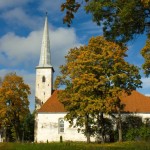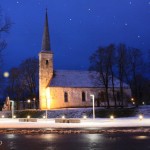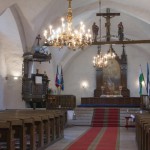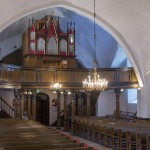The most eye-catching sight in Jõhvi itself is St Michael’s church, which is the city’s oldest building. It is the biggest single-nave church in Estonia, and also the most heavily fortified defensive church in the country. Its arched cellars house a museum in which you will hear engrossing legends about the building’s history.
The museum was born due to enthusiastic historians, people who love their town and everybody who supported even with their thoughts. The birth of this museum is an example as a good experience of activity, undertaking, ideas of different projects coming to realization.
SAINT MICHAEL’S CHURCH, JÕHVI – the most powerful fortified church in Estonia
The oldest building in Jõhvi is St. Michael’s church, which towers over the centre of the town. Though it suffered many a destruction during its long history, it was always rebuilt from the ashes left behind by the enemy forces. Which is why this church has become a genuine symbol of the historic continuity of Jõhvi, as well as being one of the finest landmarks of western Christianity on the border with Byzantine Russia.
Being close to the eastern border, which is only 50 kilometres away, and facing the constant threats of hostile neighbours, the church has also had to fulfil a defensive function. Possessing many of the defensive elements of a fort, St Michael’s is considered to have been the best-protected church in the whole of Estonia, with no comparable structures in surrounding areas.
St Michael’s Church in Jõhvi is thought to have been built in the middle of the 13th century. The first written records go back to the times of the raids of Russians in 1367, when the troops of Novgorod and the Livonian Order fought a battle in Jõhvi. The original church was destroyed at this time. Later it was rebuilt as a powerful fortified church, which in its turn was destroyed in the Livonian War in 1558.
*
The simple rectangular box-like building of the original church suggests the influence of the Cistercian Order, which owned huge territories in Alutaguse. The narrow windows were placed high on as in a stronghold. The inner sidewalls were provided with balconies so that defenders could move from one window to another. In order to prevent an enemy entering the inner church, the wooden ladders were removed and resistance continued on the balconies and above the vaults. These could be reached by the wall staircase that started at a height of 3 metres.
The unusual size of the church has been of great interest. The Church of Jõhvi is the largest single-nave church in Estonia and probably in the Baltics. (It measures 35.15 x 13.85 m inside totalling 485 m2)
*
Basement rooms were built beneath the altar, which functioned as the crypt-chapel and vestry. It is possible that some church relics were kept there. The basement rooms were connected to the chancel by two passages, which have been cleared and are now open to visitors. In Estonia such basement rooms can be found in a few monastery churches only. This tradition goes back to the Romanesque style.
It is possible to enter the church directly from the main hall, which is also a feature characteristic of the crypts of Romanesque churches and in Estonia can be found only in the Church of Jõhvi.
In 1426 the Cistercian monks sold all their land and properties in Jõhvi Parish to the Knights of the Livonian Order which rebuilt the church as a powerful fortified church in order to protect the local community against the frequent raids of their Eastern neighbours.
The church was surrounded by a wooden parapet, and above the vaults, space was cleared for ammunition, gunpowder and other necessities. The foundations of these walls were discovered during archaeological excavations in 2001. In the end a tower with numerous embrasures for firearms was built. The tower was also used by the guards to watch out for an enemy.
The hill on which the church stood was surrounded by a palisade, moat and earthworks, giving the church a fortified appearance.
The demise of the fortified church goes back to the beginning of the Livonian War when the troops of an army led by Tsar Ivan the Terrible laid siege to the church twice, and finally captured it on 3rd February 1558.
According to a chronicle of the time, more than one hundred peasants were slaughtered right in front of the altar. Their wives and children suffered the same fate. Then the church was looted and burnt to the ground.
The unusual vaulting characteristic of the Church of Jõhvi is made up of pointed tunnel vaults on the sides of which above the windows are deep gores. The cross-springers are missing and the brackets lean on the inner buttresses that were built against the sidewalls.
The only other example in Estonia of the use of inner buttresses can be found in Keila Church. The wide formerets leaning upon the buttresses make up a peculiar deep arcade, which may have been a place for side-altars in the Middle Ages.
The church got its present appearance between 1728 and 1732. J.Rabe’s baroque pulpit dates from the same period (1728). It was in Rabe’s workshop that the wooden sculptures for the Golgotha group were made.
The bells, chandeliers and the chalice of the Church of Jõhvi date back to the 17th century. The altarpiece by the Baltic German painter E.W.Liphart was presented to the church by von Dehn, the squire of Kiikla. The organ was made in Norman’s Workshop in Tallinn in 1890. The spire received its present neo-gothic appearance in 1875 (it was restored in 1984). The congregation’s house next to the church was built in 1800 and is the second oldest building in Jõhvi. (The town was almost completely destroyed in the Second World War.)
The Museum of the Fortified Church of Jõhvi was opened on St Michael’s day in 1992 in the basement rooms under the altar of St Michael’s Church. It offers visitors a genuine mediaeval atmosphere.
The visitors are led by a thirty-minute CD-guide in six languages through the history of the church, and hear the legends connected with it.
One of the basement rooms has been turned into a mysterious mediaeval crypt-chapel where relics had been kept in the past. The text is accompanied by period music and special sound effects.
The objects on display here are from the Jõhvi and Lüganuse parishes and have been found in the graves of ancient nobles and warlords. The oldest iron articles to be found in Estonia are of great importance telling us that the Iron Age in Estonia may have started here in Alutaguse 2500 years ago.
The tragic events of the Livonian War and the legend of the two brothers inspired Kai Kaljo, the artist whose glass painting can be seen on the west wall. Through the glass you can see the foundation of the once celebrated Chancel Arch.
*
To the left of the crypt chapel of the Museum there is a mysterious rectangular niche, which may once have contained the relics of the Church of Jõhvi. Today the most precious relic in the church is the 17th century silver chalice.
As a successor to the early Christian catacombs the crypt was adopted by the 13th century monks and missionaries who arrived in the Nordic area at that time, as it suited their ascetic, mystical and isolated life style. The more intimate ceremonies such as suffrages, ordered by the local feudal lords, took place in the crypt.
The Early Christian character of the crypt is emphasised by two mosaics “Christ Pantocrator” and “The Virgin Mary “ created by Eva Jänes. Placed on opposing walls they symbolise both the official religion and the popular faith, which exist side by side in our daily lives.
The creators of the rather ascetic interior design, the altar and the baptismal stone are the young designers Terje Kivist and Marje Karu.
THE LEGENDS OF THE CHURCH OF JÕHVI
Where the name has come from
It was feared in the olden days that the church might simply walk away to find a more peaceful place to settle down. In order to avoid this a man named Mihkel was sacrificed. He was buried alive in the wall of the church. The opening through which he was fed can still be seen in the wall leading down to the basement.
How the church was built
Once upon a time there lived two brothers. The elder brother went to war and asked the younger one, who stayed behind, to look after the house and to build a castle on the spot where the church is now, which he did. When the elder brother returned, he did not like what he saw. They had an argument, which led to a fight and in his rage the elder brother killed the younger brother there and then.
Seeing what he had done, he regretted his deed bitterly, had the castle pulled down and a church built in its stead.
The story goes that he wanted to be buried under the church door, so that the people going into the church would walk over his grave every Sunday. A stone cross marking that place is still there today.
The underground passage
According to a local Baltic-German legend, the church was built by the Taube feudal lords who also owned the near-by Edise Castle. The heraldic stone of the Taubes on the façade of the Church of Jõhvi is the oldest surviving example of the coat-of-arms of this famous family. They are also said to have built the Purtse Castle and the Church of Lüganuse.
The Edise Castle and the Church of Jõhvi made up an integral defence complex, which was said to have been connected by an underground passage. Local people speak about men who have seen the passage with their own eyes.
*
To manage the renovation of the Church of Jõhvi, the Society of the Museum of Jõhvi was founded in the year 2000. With assistance from the Programme for the Areas of Industrial Structuring and Jõhvi City Council the basement rooms of the Church were adapted to accommodate the Museum of the Fortified Church of Jõhvi. The Society hopes to finance further renovation work with the help of different funds.
All voluntary donations for the renovation of the Church are most welcome.
The Society of the Museum of Jõhvi/ Jõhvi Muuseumi Selts
Reg. No: 80121597
Account No: 10220009732013, Ühispank 401
Address: Rakvere mnt 6, JÕHVI 41532, Estonia
Info: tel: + 33 700 13
E-mail: annely@johvilv.ee
Text: V. Reimaa
Jõhvi 2003-11-18 C Jõhvi Muuseumi Selts
www.johvimuuseumiselts.ee
JÕHVI MUUSEUMI SELTSI INFOMATERJAL 3





